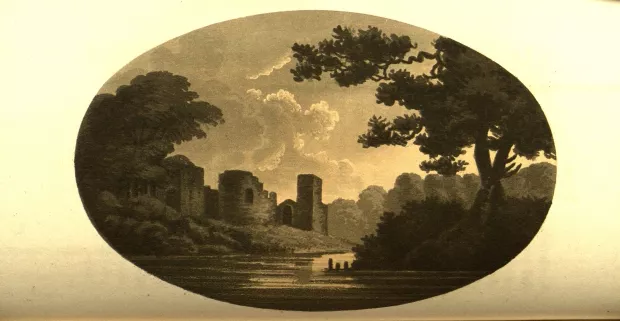Creation Date
1798
Height
12 cm
Width
18 cm
Medium
Genre
Description
The ruins of this votive chapel, built in the medieval period, are set against a dramatic, mountainous backdrop. In the aquatints depicting the ruins of Castle Abergavenny and Raglan Castle the mountains are pushed farther into the background. Furthermore, unlike the complex ruins that Gilpin typically depicts, this image features a man-made structure that is surprisingly simple. As a result, the ruins blend more easily with their surroundings, seeming to become a natural feature of the land.
Medieval ruins were valued in the Romantic period because their decaying forms were being subsumed by the landscape—stained, overrun and rent by insects and vegetation (Ruskin qtd. in Lowenthal: 157). Scholars such as Malcolm Andrews and Anne Janowitz argue that, in the attempt to unify the diverse peoples of the British Isles into one nation, ruins became sites of national memory and historic pride, material evidence of a history shared by England, Scotland and Wales (Andrews, Part I; Janowitz 4). Several primary sources support this opinion. A ruined mansion in Brambletye was the occasion for John Byng to contrast his own era to "those Gothic days":
Over and about these ruins I . . . meditated . . . [on] the great improvements of the roads, which have introduced learning and the arts into the country and removed the (formerly wretched) families, who buried themselves in mud and ignorance, to the gay participation of wit and gallantry in the parishes [towns] of Marylebone and St. James! (Byng 89)
Similarly, when Reverend Stebbing Shaw, an English antiquarian, was confronted with the ruins of Abingdon Abbey, he associated them with the importance of the West Saxons and the famed medieval Welsh historian Geoffrey of Monmouth (Mavor 156). Much tourist literature of the time engaged in similar historical reassembly or reconstruction, often blurring the lines between the cultures of the British Isles. The chapel on the Cornish Tamer River, nestled in a dramatic mountain range, can consequently be seen as both an artifact of English history and as a symbol of the diversity of the British nation.
A broad expanse of river fills the foreground of the image, narrowing in the center ground and stretching away from the viewer. A rocky bluff—descending in steep gradations to the water's edge—fills the left portion of the image. Shrubs and trees are sparse on its rocky face. Further to the left and nearly obscured by the shadow of the bluff, an animal grazes in a cluster of trees. On the other side of the bluff, on a bit of land that juts out past its foot, is a low boxy (man-made) structure. Two more mountains rise in the background, their faces vaguely rocky, and their peaks blurring with the cloudy sky. Nestled in the surrounding mountains, the small votive chapel along the Tamer River appears to be absorbed by the surrounding landscape. This seemingly organic mingling of land and man-made structures was highly valued by the picturesque aesthetic.
Associated Works
Locations Description
Boldre
One of Gilpin’s former students at Cheam, Colonel William Mitford, heard of his former schoolmaster’s desire to retire from the school at Cheam and offered him a wage in Boldre. Gilpin accepted, and he served as the Vicar of Boldre, Hampshire from 1777 until his death in 1804 (Templeman 148). From the beginning of this appointment until 1791, he kept up his drawing while attending to the affairs of his new parish community. He initiated an association to aid the impoverished in the neighboring town of Lymington and supported the foundation of Sunday and day schools in Boldre (Templeman 186-91). The revenues from sales of his Tours allowed him to establish two schools in Boldre in 1791 (Gilpin: qtd. in Templeman 194). Between 1797 and 1800, a period of prolonged illness, he published another set of sermons and additional accounts of his domestic travels (Observations on the Western Parts of England), as well as working to arrange the the posthumous sale of his works in order to establish an endowment for his schools (Barbier 92; Templeman 207-9).
Copyright
Copyright 2009, Department of Special Collections, Memorial Library, University of Wisconsin-Madison, Madison, WI
Publisher
R. Blamire
Collection
Additional Information
Bibliography
Andrews, Malcolm. The Search for the Picturesque: Landscape Aesthetics and Tourism in Britain, 1760-1800. Stanford: Stanford UP, 1989. Print.
Barbier, Carl Paul. William Gilpin: His Drawings, Teaching, and Theory of the Picturesque. Oxford: Clarendon P, 1963. Print.
Bermingham, Ann. "The Picturesque and Ready-to-wear Femininity." The Politics of the Picturesque: Literature, Landscape, and Aesthetics since 1770. Ed. Stephen Copley and Peter Garside. Cambridge: Cambridge UP, 1994. Print. 81-119.
Byng, John. Byng's tours: The Journals of the Hon. John Byng, 1781-1792. Ed. David Souden. London: Century in Association with The National Trust, 1991. Print. National Trust Classics.
Gilpin, William. Observations on the Coasts of Hampshire, Sussex, and Kent : Relative Chiefly to Picturesque Beauty: Made in the Summer of the Year 1774. London, 1804. Print.
---. Observations on the River Wye, and Several Parts of South Wales, &c.: Relative Chiefly to Picturesque Beauty; Made in the Summer of the Year 1770. 3rd ed. London, 1792. Print.
---. Three Essays: On Picturesque Beauty; on Picturesque Travel; and on Sketching Landscape: to Which Is Added a Poem, on Landscape Painting. London, 1792. Eighteenth Century Collections Online. Gale. University of Wisconsin - Madison. 21 May 2009.
Janowitz, Anne F. England's Ruins: Poetic Purpose and the National Landscape. Cambridge, MA: Blackwell. 1990. Print.
Lowenthal, David. The Past is a Foreign Country. Cambridge: Cambridge UP, 1985. Print.
Templeman, William D. The Life and Work of William Gilpin (1724-1804): Master of the Picturesque and Vicar of Boldre. Urbana: U of Illinois P, 1939. Print. University of Illinois Studies in Language and Literature 24.3-4.

